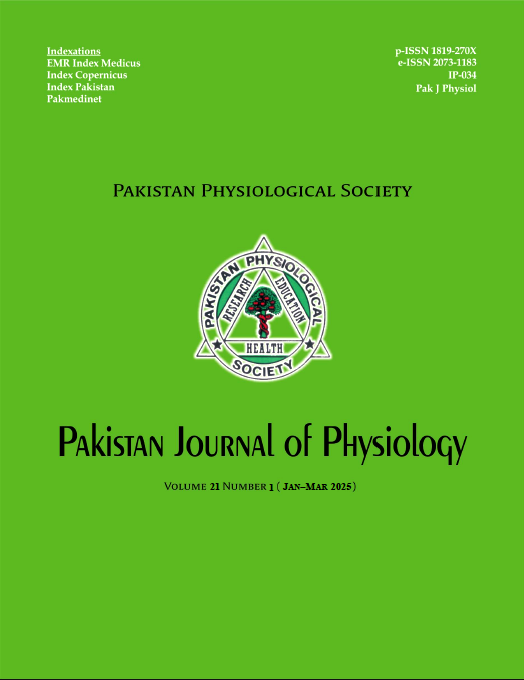EXHUMATION: A GATEWAY TO THE HIDDEN JUSTICE, FORENSIC AND PHYSIOLOGICAL TALE TO THE TRUTH
DOI:
https://doi.org/10.69656/pjp.v21i1.1667Keywords:
Exhumation, Section 176 CrPC, Re-post mortem, Forensic, Physiology, AnatomyAbstract
Background: Exhumation is important in medico-legal investigations and is under debate since long for its usefulness. Critics also try to relate these with the religion and label it as destroying the human dead body as this is a belief that we don’t achieve desired results by exhumation. This study was carried out to assess the usefulness of exhumation and its outcome in our set-up and circumstances. Methods: This retrospective study was conducted in Ayub Teaching Hospital and supervised cases of Benazir Bhutto Shaheed Teaching Hospital, Abbottabad. Total 27 cases were studied in a 2 year time. Medico-legal aspects were studied keeping in view the physiological process in the body and anatomical destruction after death. Results: We were able to detect cause of death in 53% cases (23% burning, 19% firearm, 4% drowning, and 7% cut-throat cases); 33% in 0–20 years, 45% in age group 20–40 years, 8% in 40–60 years, and 14% in >60 years. Major reason for doing exhumation was to find out the cause of death (in 47% cases), followed by identity and not doing initial post mortem in 19% cases, and re-autopsy in 15% of cases. Conclusion: Exhumation should be ordered and conducted as it helps the investigators in determining the reasons behind the death and solve the mystery in determining the cause of death after doing this procedure and aid in administration of justice.
Pak J Physiol 2025;21(1):84-6, DOI: https://doi.org/10.69656/pjp.v21i1.1667
Downloads
References
Maqsood M, Butt MK, Arif M, Sibtain A. Exhumation —can dead tell tales. J Fatima Jinnah Med Coll 2013;7(4):48–52.
Mughal MI, Parveen Z. Role of exhumation in determination of cause of death. Postgrad Med J 1999;10(1):31–4.
Bardale R, Exhumation. In: Bardale R. (Ed). Principles of Forensic Medicine and Toxicology. 1st ed. New Delhi: Jaypee Publishers; 2011.p. 126–7.
Grellner W, Glenewinkel F. Exhumations: synopsis of morphological and toxicological findings in relation to the postmortem interval. Survey on a 20-year period and review of the literature. Forensic Sci Int 1997;90(1-2):139–59.
Verhoff MA, Ulm K, Kreutz K, Muller KM, Srachetzki U. Exhumation as a matter of fact. Anil Aggarwal’s Internet J Forensic Med Toxicol 2007;8(1). Available from: https://anilaggrawal.com/ ij/vol_008_no_001/papers/paper002.html. [Accessed 4 Aug 2024]
Ammani J, Sai Sudheer T, Roopesh. Analytical study of exhumations and its medico-legal importance. Int J Contemp Med Res 2016;3(4);972–5.
Hamayun M, Khichi HZ, Chand H, Khan O, Asadullah. Exhumation —A key to provide justice to victims of homicide: Situation in Larkana and Sukkur divisions. J Ayub Med Coll Abbottabad 2010;22(1):168–70.
Suresh V, Jyothi S, Cyriac AJ. Analysis of postmortem examination in exhumed cases done in and around Bangalore, India for 10 years: A retrospective study. Int J Tixicol Forensic Med 2022;12(3):37680.
Albano GD, Zerbo S, La Spina C, Midiri M, Guadagnino D, D'Anna T, et al. Toxicological analysis in tissues following exhumation more than two years after death (948 days): a forensic perspective in a fatal case. Toxics 2023;11(6):485.
Willeman T, Allibe N, Sauerbach L, Barret A, Eysseric-Guerin H, Paysant F, et al. Homicidal poisoning series in a nursing home: Retrospective toxicological investigations in bone marrow and hair. Int J Leg Med 2021;136:123–31.
Ueland M, Nizio KD, Forbes SL, Stuart BH. The interactive effect of the degradation of cotton clothing and decomposition fluid production associated with decaying remains. Forensic Sci Int 2015;255:56–63.
Rani M, Kumar P, Kumar M, Rani Y. Exhumation and identification: A case report. Indian Acad Forensic Med 2012;34(4):361–3.
Downloads
Published
How to Cite
Issue
Section
License
Copyright (c) 2025 Omair Khan, Salma Shazia, Muhammad Atif Khan, Alruba Taimoor, Aftab Tanoli, Mashook Ali

This work is licensed under a Creative Commons Attribution-NoDerivatives 4.0 International License.
The author(s) retain the copyrights and allow their publication in Pakistan Journal of Physiology, Pak J Physiol, PJP to be FREE for research and academic purposes. It can be downloaded and stored, printed, presented, projected, cited and quoted with full reference of, and acknowledgement to the author(s) and the PJP. The contents are published with an international CC-BY-ND-4.0 License.












